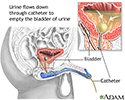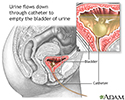Urine culture - catheterized specimen
Culture - urine - catheterized specimen; Urine culture - catheterization; Catheterized urine specimen cultureCatheterized specimen urine culture is a laboratory test that looks for germs in a urine sample.
How the Test is Performed
This test requires a urine sample. The sample is taken by placing a thin rubber tube (called a catheter) through the urethra into the bladder. A nurse or a trained technician may do this.
First, the area around the opening of the urethra is thoroughly washed with a germ-killing (antiseptic) solution. The tube is inserted into the urethra. The urine drains into a sterile container, and the catheter is removed.
Rarely, your health care provider may choose to collect a urine sample by inserting a needle directly into the bladder from the abdominal wall and draining the urine. However, this is most often done only in infants or to immediately screen for bacterial infection.
The urine is sent to a laboratory. Tests are done to determine if there are germs in the urine sample. Other tests may be done to determine the best medicine to fight the germs.
How to Prepare for the Test
Do not urinate for at least 1 hour before the test. If you don't have the urge to urinate, you may be instructed to drink a glass of water 15 to 20 minutes before the test. Otherwise, there is no preparation for the test.
How the Test will Feel
There is some discomfort. As the catheter is inserted, you may feel pressure. If you have a urinary tract infection, you may have some pain when the catheter is inserted.
Urinary tract infection
A urinary tract infection, or UTI, is an infection of the urinary tract. The infection can occur at different points in the urinary tract, including...

Why the Test is Performed
The test is done:
- To get a sterile urine sample in a person who cannot urinate on their own
- If you might have a urinary tract infection
- If you cannot empty your bladder (urinary retention)
Normal Results
Normal values depend on the test being performed. Normal results are reported as "no growth" and are a sign that there is no infection.
What Abnormal Results Mean
A "positive" or abnormal test means germs, such as bacteria or yeast, are found in the urine sample. This likely means that you have a urinary tract infection or a bladder infection. If there is only a small amount of germs and you have no symptoms, your provider may not recommend treatment.
Sometimes, bacteria that do not cause urinary tract infections may be found in the culture. This is called a contaminant. You may not need to be treated.
People who have a urinary catheter all of the time may have bacteria in their urine sample, but it does not cause a true infection. This is called being colonized.
Urinary catheter all of the time
You have an indwelling catheter (tube) in your bladder. "Indwelling" means inside your body. This catheter drains urine from your bladder into a ba...
Read Article Now Book Mark ArticleRisks
Risks include:
- Perforation (hole) in the urethra or bladder from the catheter
- Infection
References
Dean AJ, Lee DC. Bedside laboratory and microbiologic procedures. In: Roberts JR, Custalow CB, Thomsen TW, eds. Roberts and Hedges' Clinical Procedures in Emergency Medicine and Acute Care. 7th ed. Philadelphia, PA: Elsevier; 2019:chap 67.
Germann CA. Urologic disorders. In: Walls RM, ed. Rosen's Emergency Medicine: Concepts and Clinical Practice. 10th ed. Philadelphia, PA: Elsevier; 2023:chap 85.
James RE, Fowler GC. Bladder catheterization (and urethral dilation). In: Fowler GC, ed. Pfenninger and Fowler's Procedures for Primary Care. 4th ed. Philadelphia, PA: Elsevier; 2020:chap 96.
Trautner BW, Hooton TM. Health care-associated urinary tract infections. In: Bennett JE, Dolin R, Blaser MJ, eds. Mandell, Douglas, and Bennett's Principles and Practice of Infectious Diseases. 9th ed. Philadelphia, PA: Elsevier; 2020:chap 302.
-
Female urinary tract - illustration
The female and male urinary tracts are relatively the same except for the length of the urethra.
Female urinary tract
illustration
-
Male urinary tract - illustration
The male and female urinary tracts are relatively the same except for the length of the urethra.
Male urinary tract
illustration
-
Bladder catheterization - male - illustration
Catheterization is accomplished by inserting a catheter (a hollow tube, often with and inflatable balloon tip) into the urinary bladder. This procedure is performed for urinary obstruction, following surgical procedures to the urethra, in unconscious patients (due to surgical anesthesia, coma, or other reasons), or for any other problem in which the bladder needs to be kept empty (decompressed) and urinary flow assured. The balloon holds the catheter in place for a duration of time. Catheterization in males is slightly more difficult and uncomfortable than in females because of the longer urethra.
Bladder catheterization - male
illustration
-
Bladder catheterization - female - illustration
A catheter (a hollow tube, often with an inflatable balloon tip) may be inserted into the urinary bladder when there is a urinary obstruction, following surgical procedures to the urethra, in unconscious patients (due to surgical anesthesia, coma, or other reasons), or for any other problem in which the bladder needs to be kept empty (decompressed) and urinary flow assured. The balloon holds the catheter in place for a duration of time.
Bladder catheterization - female
illustration
-
Female urinary tract - illustration
The female and male urinary tracts are relatively the same except for the length of the urethra.
Female urinary tract
illustration
-
Male urinary tract - illustration
The male and female urinary tracts are relatively the same except for the length of the urethra.
Male urinary tract
illustration
-
Bladder catheterization - male - illustration
Catheterization is accomplished by inserting a catheter (a hollow tube, often with and inflatable balloon tip) into the urinary bladder. This procedure is performed for urinary obstruction, following surgical procedures to the urethra, in unconscious patients (due to surgical anesthesia, coma, or other reasons), or for any other problem in which the bladder needs to be kept empty (decompressed) and urinary flow assured. The balloon holds the catheter in place for a duration of time. Catheterization in males is slightly more difficult and uncomfortable than in females because of the longer urethra.
Bladder catheterization - male
illustration
-
Bladder catheterization - female - illustration
A catheter (a hollow tube, often with an inflatable balloon tip) may be inserted into the urinary bladder when there is a urinary obstruction, following surgical procedures to the urethra, in unconscious patients (due to surgical anesthesia, coma, or other reasons), or for any other problem in which the bladder needs to be kept empty (decompressed) and urinary flow assured. The balloon holds the catheter in place for a duration of time.
Bladder catheterization - female
illustration
Review Date: 4/27/2023
Reviewed By: Linda J. Vorvick, MD, Clinical Professor, Department of Family Medicine, UW Medicine, School of Medicine, University of Washington, Seattle, WA. Also reviewed by David C. Dugdale, MD, Medical Director, Brenda Conaway, Editorial Director, and the A.D.A.M. Editorial team.






